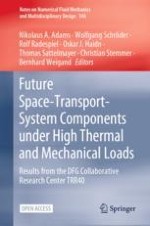1 Introduction
2 Virtual Thrust Chamber Demonstrators
-
TCD1, a thrust chamber for upper stage application using the expander cycle with focus on mass reduction by shortening of the cylindrical section.
-
TCD2, a thrust chamber for main stage application using the gas generator cycle with focus on pressure drop reduction for the relaxation of turbomachinery requirements.
-
TCD3, a thrust chamber for main stage application using the gas generator cycle with focus on fuel flexibility, i.e. a single combustion chamber capable of operating with either O\(_\text {2}\)/H\(_\text {2}\) or O\(_\text {2}\)/CH\(_\text {4}\) and reuseability.
Parameter | Symbol | Unit | TCD1 | TCD2 | TCD3 | TCD3 |
|---|---|---|---|---|---|---|
Propellant combination | H\(_\text {2}\)/O\(_\text {2}\) | H\(_\text {2}\)/O\(_\text {2}\) | H\(_\text {2}\)/O\(_\text {2}\) | CH\(_\text {4}\)/O\(_\text {2}\) | ||
Chamber pressure | \(p_\text {c}\) | bar | 55 | 100 | 107 | 100 |
Mixture ratio | ROF | – | 5.6 | 6.0 | 6.0 | 3.4 |
Thrust | F | kN | 100 | 1000 | 1000 | 1000 |
Total mass flow rate | \(\dot{m}_\text {tot}\) | kg/s | 21.45 | 226.70 | 238.67 | 282.83 |
